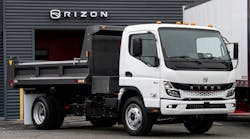Today, the U.S. Environmental Protection Agency (EPA) and the National Highway Traffic Safety Administration (NHTSA) published in the Federal Register its joint notice of proposed rulemaking for “Greenhouse Gas Emissions Standards and Fuel Efficiency Standards for Medium and
Heavy-Duty Engines and Vehicles.”
The rulemaking stems from a Congressional mandate issued in 2007 and by an Executive Order issued by President Obama earlier this year. Public comments on the proposal are due to the agencies no later than January 31st.
The so-called GHG-MPG rule was crafted jointly by EPA and NHTSA using a “tiered” design to cover three distinct vehicle categories: (1) heavy trucks and tractor-trailers; (2) heavy-duty pickups and vans; and (3) and vocational vehicles.
For tractor-trailers, the proposed engine and vehicle standards begin in the 2014 model year and establish a 20% reduction in CO2 emissions and fuel consumption by the 2018 model year.
For heavy-duty pickup trucks and vans, the proposal calls for separate gasoline and diesel truck standards, which would phase in starting with the 2014 model year. These standards would be expected to achieve up to a 10% reduction for gasoline vehicles and 15% reduction for diesel vehicles by the 2018 model year (12% and 17% respectively, if accounting for air conditioning leakage).
For vocational vehicles, the proposed engine and vehicle standards would kick in for the 2014 model year and are targeted to up to a 10% reduction in fuel consumption and CO2 emissions by the 2018 model year.
EPA has stated the new rules would reduce GHG emissions by nearly 250 million metric tons, cut carbon monoxide emissions by 11,000 million metric tons, eliminate 33,000 million metric tons of oxides of nitrogen (NOx), and remove 12,000 million metric tons of particulate matter (PM).
“We’ve said all along that such regulations offer a transition to lower pollution and less energy use by the transportation sector,” EPA Administrator Lisa Jackson told reporters in a conference call last month. “What makes such regulations so successful is that they are performance standards that [establish] a roadmap many years out to provide flexibility so manufacturers can meet them in the most cost effective way.”
According to the notice in the Federal Register, comments submitted on the joint GHG-MPG rule should be identified by Docket ID No. NHTSA–2010–0079 and/or EPA–HQ–OAR–2010–0162, by one of the following methods:
http://www.regulations.gov Follow the on-line instructions for submitting comments.
E-mail: [email protected].
Fax: NHTSA: (202) 493–2251;
EPA: (202) 566–9744.
Mail:
NHTSA: Docket Management Facility,
M–30, U.S. Department of
Transportation, West Building, Ground
Floor, Rm. W12–140, 1200 New Jersey
Avenue, SE., Washington, DC 20590.
EPA: Air Docket, Environmental
Protection Agency, EPA Docket Center,
Mailcode: 6102T, 1200 Pennsylvania
Ave., NW., Washington, DC 20460.
In addition, the agencies request those commenting to also “please mail a copy of your comments on the information collection
provisions to the Office of Information and Regulatory Affairs, Office of Management and Budget (OMB), Attn:
Desk Officer for EPA, 725 17th St., NW., Washington, DC 20503.
All public comments on the proposal are due to the agencies no later than January 31st.


